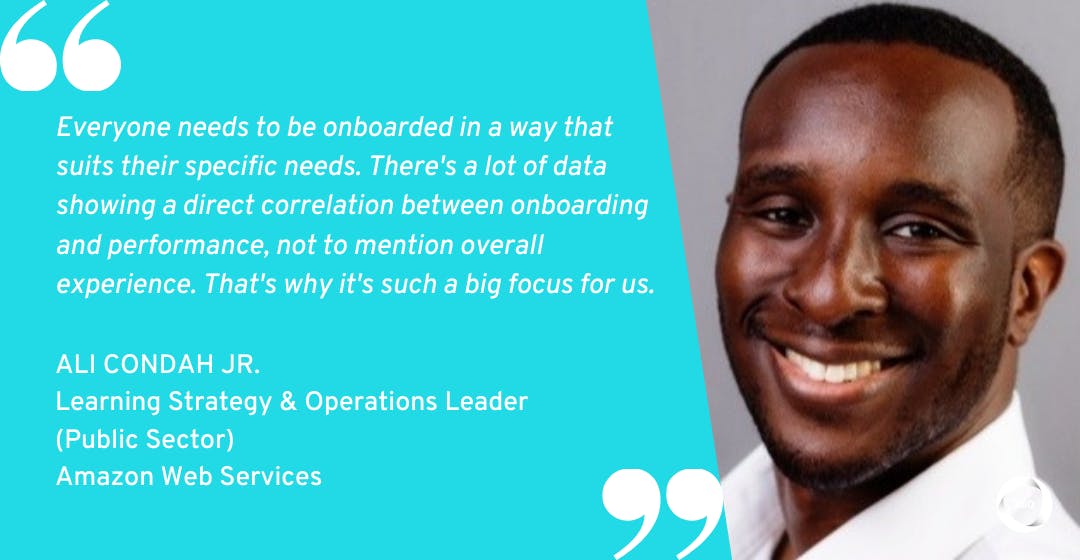Amazon is a company that really needs no introduction. Chances are you’re only a few feet away from one of their packages right now–especially during the COVID-19 pandemic when so many of us have been stuck at home.
As part of Amazon’s huge growth during 2020, Amazon Web Services has also continued to expand, providing organizations around the world with cloud computing services and API support. This expansion has meant big changes for AWS teams–including sales enablement.
Recently, I sat down with Ali Condah Jr., Learning Strategy and Operations Leader (Public Sector) at AWS, to talk about these changes. Ali was kind enough to tell me all about his four-step playbook for great sales enablement at AWS, and how he measures his impact.
We got started by talking about AWS’s growing focus on working with public sector organizations.
AWS’s focus on working with public sector organizations
As Ali explains, AWS is a growing organization, and is working with new clients and customers each and every month. Its strategy and operations teams have a critical role to play in managing this growth.
“In my current role, I’m focusing on public sector sales enablement,” says Ali. “We’re a sizable group, and we’re growing fast, because we’ve made an investment in enablement resources dedicated to our customer-facing individuals targeting public sector audiences.”
“We’re working with solutions architects, people in professional services, sellers, operations folks, and many others. Amazon is a very big organization, so people need information quickly. We have to balance our training needs against that need for prompt information.”
For Ali, another key challenge is being clear on which of AWS’s customers fall within the category of ‘public sector’.
“When people hear the term ‘public sector’, they think about federal and state governments,” he says. “But it’s much broader than that. It includes non-profit organizations, and universities with their own healthcare systems. You can’t target every non-profit organization the same way you might target the US federal government. They’re completely different organizations.”
“Whether we’re targeting non-profits or big government organizations, you need to be very targeted with your sales enablement. Otherwise, you’re not going to come across as a strategic business consultant.”
Related: 3 Essential Tips to Create Engaging Training for Your Sales Teams
Whether we’re targeting non-profits or big government organizations, you need to be very targeted with your sales enablement.
Need a few more CLO Connect expert insights? Find out How L&D Can Help Your Company Scale
The AWS 4-step playbook for targeted sales enablement
For Ali, delivering this targeted sales enablement involves a four-step playbook focusing on relationships, onboarding, localized content, and team collaboration.
#1. Building trusted relationships
Like so many business functions, sales enablement starts with building the right relationships. In Ali’s experience, this should be a priority from day one.
“I use the same philosophy whenever I start at an organization,” he says. “I get in, I understand who my stakeholders are, who I need to partner with, what our common challenges are, and what our organization’s goals are.”
“By going through this learning exercise and building these relationships, I can find the common threads shared by those who have been successful within the organization. I can also find the things that have made people want to bump their heads against the wall.”
One particular advantage of building these relationships? Knowing where to find the right information. “There’s always so much information around,” says Ali. “Making it accessible and putting it somewhere people can find it has always been a challenge in sales enablement.”
There’s always so much information around. Making it accessible and putting it somewhere people can find it has always been a challenge in sales enablement.
#2. Decreasing ramp-up time with great onboarding
Alongside this focus on building relationships, Ali’s sales enablement playbook also focuses on getting onboarding right for new hires.
“The key question is: how can we reduce the amount of time we spend getting people up to speed? How can we get people to ramp-up faster? Generally, that’s where I focus my energies, because it helps us out a lot.”

As Ali explains, this onboarding focus is particularly important for businesses growing at pace. “Amazon is already a big organization, and we’re continuing to bring on more people. That’s why onboarding is such a big focus for me. We’re trying to target that at different role levels, from the early career individuals to the most senior positions.”
“Everyone needs to be onboarded the right way, and in a way that suits their specific needs. There’s a lot of data showing a direct correlation between onboarding and performance, not to mention overall employee experience. That’s why it’s such a big focus for us.”
Related: The 360Learning Onboarding Playbook
#3. Localizing sales enablement content
One of the most important parts of sales enablement in a global company like Amazon? Tailoring content to suit the needs of a specific group of clients. This localization forms a key step in Ali’s sales enablement playbook.
“Localizing content is a key skill in sales enablement,” says Ali. “When a lot of people think of localization they think of translation. ‘We’ve got something in English, let’s shift it into Brazilian Portuguese’. While that is one facet, this process of localizing is much broader than that.”
“For me, localization means knowing how to target your audience. For those of us based in the United States, we tend to build things and ship them out to the world. Then, we wonder why everyone isn’t on board with what we’re suggesting.”
To illustrate his point, Ali turns to food. “If you live in the D.C. region and you’re selling chicken wings, but you don’t have Mumbo sauce, you lose credibility with the customer. The same goes for non-profit organizations. You have to be able to speak their language and understand their challenges. When we localize, we’re targeting our messaging for a specific audience.”
Related: The 3 Biggest Challenges of Remote Sales Training and How to Overcome Them
If you live in the D.C. region and you’re selling chicken wings, but you don’t have Mumbo sauce, you lose credibility with the customer. The same goes for non-profit organizations. You have to be able to speak their language and understand their challenges.
#4. Collaborating across teams to reflect the customer journey
In every company, great sales enablement is a team effort. This is definitely true for AWS, and it’s why collaboration between teams is the fourth step of Ali’s playbook.
“In sales enablement, I’ve had to become very good friends with our marketing departments, with professional services, and with the operations team,” says Ali. “I also encourage our new hires to spend time with our customer service representatives too, because listening to these calls helps you to understand the types of challenges your existing customers are facing.”
“We need to align sales enablement to the customer journey, looking at every single step and working with the individuals involved. Sometimes I even go broader than that, and I work with finance to see what our billing looks like, what we have coming in, and where we might have challenges. I invest a lot of time in trying to understand my organization.”
One other key factor on top of this collaboration between teams? Building the right skill sets within the sales enablement team. “I try to build a team where we can leverage each other’s skill sets,” says Ali. “I have people on my team right now who are great at video editing, whereas some people are experienced in adult learning, or multimedia design.”
“We also have people who are specialized in determining ROI and effectiveness. These are all key foundational skills in sales enablement that I continue to strive for in my team now.”
And speaking of ROI...
We need to align sales enablement to the customer journey, looking at every single step and working with the individuals involved.
Tracking the impact of sales enablement at AWS
So, that’s Ali’s four-step playbook for targeted sales enablement. But how does he know he’s making the right impact? As he explains, it’s all about knowing what other teams need, then delivering it.
“Where you can really add value with sales enablement is finding out what is going to help the wider parts of the organization. What’s going to make the biggest impact for professional services? What about marketing?”
For Ali, this doesn’t need to be a complicated process. “Oftentimes, professional services will tell me that they just want to make sure our salespeople are selling the right things, and that the customer knows what they’re getting. If we can help them solve that, we’ll be best friends.”
“Eventually, our goal is to drive more revenue, and to drive revenue in the right ways. We always get there, but I start with these foundational questions, because that’s how you earn trust from people, including key leadership. Then you know you’re making the right impact.”
Related: 3 Data-Based Ways to Provide Training ROI (+ Free Training ROI Calculator)
Thanks again to Ali for taking the time to share his sales enablement insights!
While you’re here, check out my expert interviews with Jennifer Recla of Colorado Access on how to support healthcare innovation with L&D, and with Gauresh Gaitonde of NeoSOFT about creating amazing learning experiences for IT teams.
Want more peer insights on transforming workplace learning? Check out #CLOConnect, our interview series with top L&D leaders on driving growth and scaling culture through Collaborative Learning. Or you can subscribe (below 👇) to our weekly newsletter to receive our latest posts directly in your inbox.



